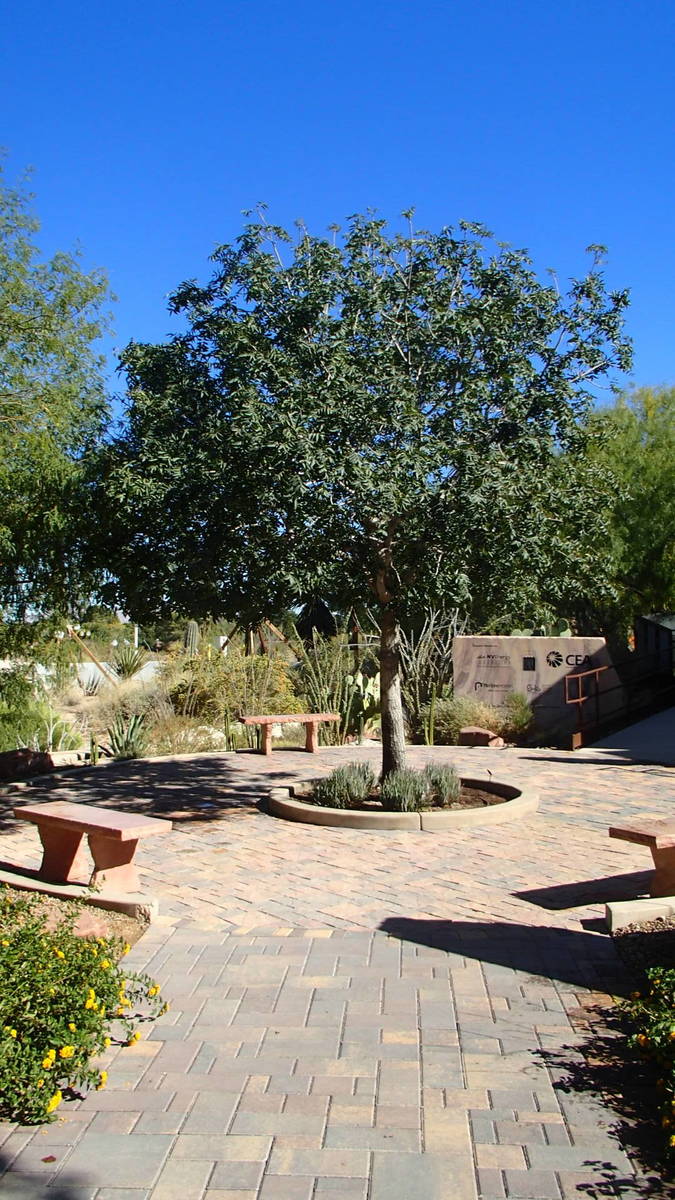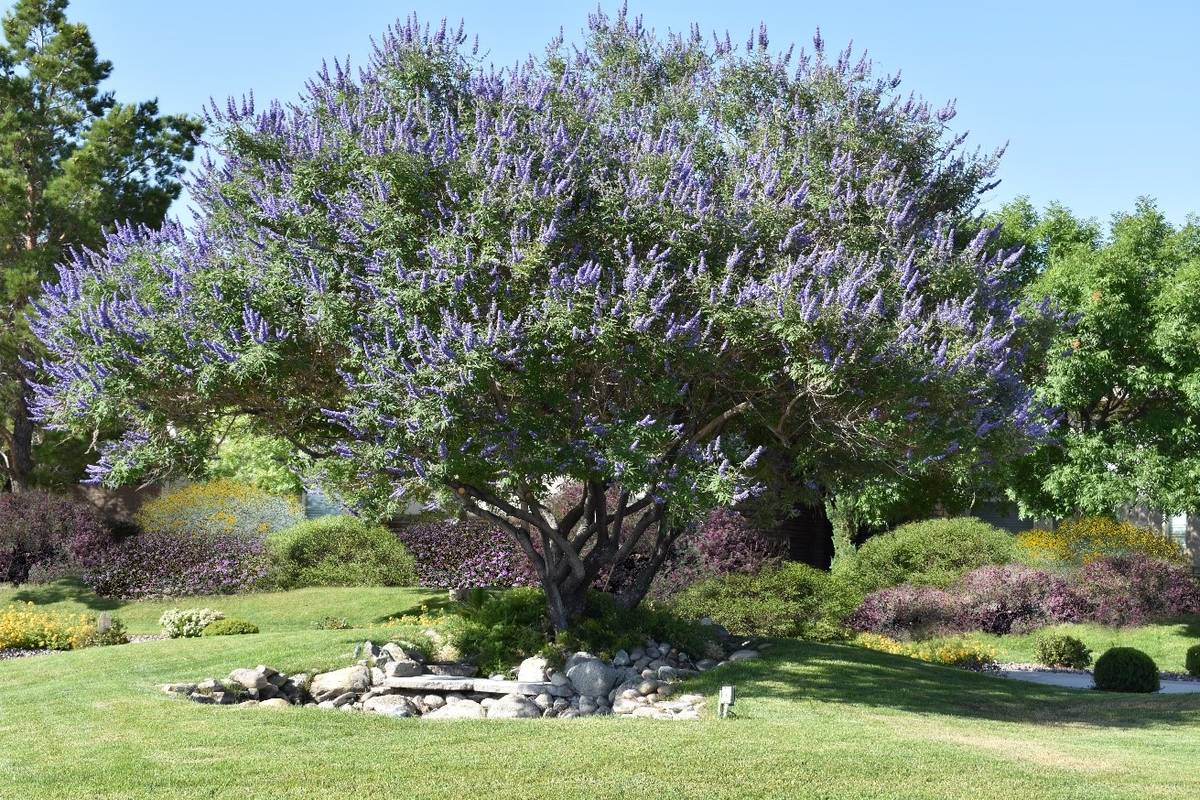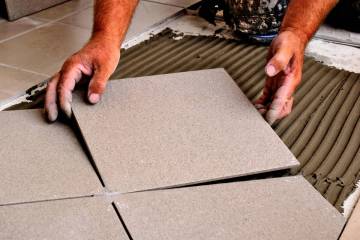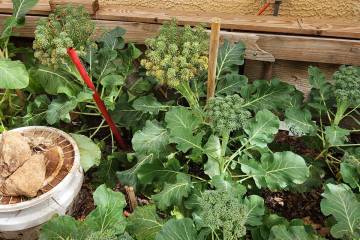Chinese pistache best suited for community of two-story homes
Q: I am on the board of directors of a local HOA, and we need to replace our plum and pear trees. We have lots of wind. Our landscaping company recommends a pistache tree to replace the ornamental pear. Will that do well planted in the strips along our entrance and throughout the community?
A: The Chinese pistache is a good choice in the desert as a general landscape, street or lawn tree. The pluses: It has fewer problems than the pear tree and uses about the same amount of water. It handles wind better than pear or plum trees.
The negatives are possibly its size and water use. Chinese pistache is not a big tree and it’s not a small tree. It’s in between. It is mesic in water use, grows to about 30 feet in height and the same size in width. Don’t get me wrong. It doesn’t use as much water as the large mulberry with its big leaves and fast growth.
In terms of its size, it is best suited for a subdivision that includes two-story homes. If your HOA has all single-story homes, then consider smaller mature trees in the 20-foot “at maturity” height range.
Smaller trees growing among smaller homes is visually more appealing. Smaller mesic trees use less water than medium-sized mesic trees when mature. Smaller xeric trees use even less water when irrigated less often.
A word of caution when you are selecting replacement trees. Select a mixture of different kinds of trees in a community landscape. Having a mixture of trees reduces potential costly outbreaks of diseases or insect pests that could sweep through a community of identical trees in the future.
If you are having trouble selecting a plant, look online at the plant database found at SNWA. Cross-reference your selection with Arizona State University’s plant database in Tempe, Arizona. Select important trees used in your landscape that survive a low winter temperature of 20 degrees Fahrenheit. Use a minimum temperature of 25 degrees for plants that you can afford to lose every few years.
Q: I read that summertime is when roses “sleep” in the desert heat. Can I prune my rose bushes in June and let them grow and flower through the winter months?
A: I wouldn’t. Roses don’t really sleep or become dormant during the summer months, but they struggle instead with the heat and intense sunlight. Therefore, they might stop flowering and look bad. The ideal temperature for most roses is around 65 degrees and comfortable growth can range as high as 82 degrees. Temperatures higher than this range produce increasing plant stress.
Intense direct sunlight causes considerable damage to previously shaded stems if roses are pruned and opened up in the summer.
Allowing intense sunlight inside the plant canopy is the major reason I wouldn’t prune roses during the summer. If you were living in Seattle or San Francisco, I would tell you to go ahead and prune in the summer.
Q: We want to plant some tropical trees and shrubs in our garden. Should I turn the soil in the whole flower beds over and amend the soil, or should I only dig holes where the plants go and fill the holes with amended soil?
A: A lot depends on the soil that you have, but I think you can amend the existing soil where these plants will grow and won’t need to amend the entire area. Keep tropical plants grouped together for planting and irrigating ease.
Cover the area where these plants are growing with a thick wood chip surface layer (mulch) when you are finished. You will rely on the wood chips decomposing to improve the soil where roots will be growing over the next few months.
After planting, surround each plant with a doughnut of soil about 3 to 4 inches deep. This ring acts as a water reservoir to get the applied water deeper in the soil. Smaller plants have smaller rings; bigger plants have bigger rings. Water daily the first few days after planting and before turning it over to an irrigation system.
Q: I have 11-year-old, 4-foot-tall palm trees that are in 25- or 30-gallon pots in my backyard that get direct sunlight every day. What kind of watering cycle should they be getting during the hot summer and throughout the year? Also, what kind of nutrients should I be adding to them and how often?
A: Containers will dry out faster on the south and west sides if they are in full sun. Those sides of the container are notorious for getting super hot and killing roots. Shading the container or putting the existing container in a second larger container prevents that.
Always water in the morning before it gets hot. How much and how often to apply water depends on the soil in the container. Buy an inexpensive moisture meter used for monitoring houseplants to gauge when to water again. Push the tip of the moisture meter in the soil about 4 inches deep. Do this in three different spots so you can get an average reading. When the average reading is near 5, water again.
Fertilize container plants more often than plants growing in the ground. The application frequency varies from once a month to three or four times a year. The same amount is applied over the course of a year, but the amount applied each time is split into monthly or quarterly applications.
The best way to judge when an application of fertilizer is needed is by using leaf color and plant growth as indicators. Plants with enough fertilizer are dark green and have strong growth.
When you water, a little bit should always come out the bottom of the container. This helps remove salts that might otherwise accumulate in the soil. Apply fertilizer after every 40 waterings.
Q: My chaste tree bloomed beautifully once in early spring but nothing since. Now it just has seeds where the blooms were. Do I need to cut the spent spikes off?
A: Vitex blooms once in about June. Most vitex varieties have blue flowers, but some are white and some rose-colored. The flowers turn to seed. The seed germinates anywhere there is water. Some think these seed pods are unsightly. If you agree, cut them off but it is not necessary.
Vitex isn’t considered a desert tree (xeric) but mesic instead. It is small and grows very nicely in the heat of the desert if it gets water. Make sure it gets lots of water the month prior to flowering, and the flowering will be spectacular. The rest of the year, water as you would any other plant in your landscape.
Q: I am interested in air layering my peach tree. What time of year would it be best to do air layering? Also, would it be bad to try during the hot summer?
A: Air layering, also called marcottage, is a way of growing roots on a stem while it is still attached to the mother plant. Air layering is used frequently when plants are difficult to propagate from stem cuttings. The best time to air layer plants is the same time as planting them: spring and fall.
You also can propagate peach and nectarine from stem cuttings. The size that works best is pencil diameter and taken during the winter months after leaf drop. These hardwood cuttings grow roots best if a rooting hormone is applied soon after the cutting is made and stuck into a propagation medium.
When propagating peach and nectarine either by air layering or stem cuttings, the important advantage of a grafted rootstock is lost. The rootstock on peach and other stone fruits can play an important role. It can control the tree’s eventual size, how soon it starts to bear fruit, resistance to some diseases and even the fruit flavor.
Bob Morris is a horticulture expert and professor emeritus of the University of Nevada, Las Vegas. Visit his blog at xtremehorticulture.blogspot.com. Send questions to Extremehort@aol.com.
























